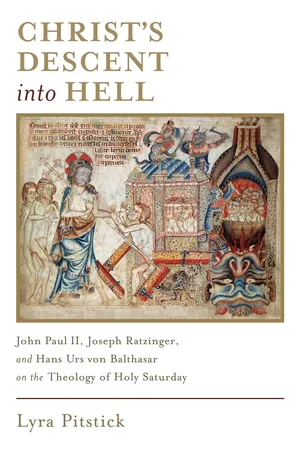![]()
1
Balthasar on the Descent
According to Balthasar, Christ’s descent into hell is the pinnacle of the Trinity’s self-revelation in salvation history. In this event, God’s love remains unscathed by His descent into — and real union with — what is most not Himself, sin and the abandonment by God that is its punishment. The sovereign freedom necessary to punish sin and embrace this justice in love for the world’s redemption will manifest God’s trinitarian divinity.
Four specific details can help fill out this summary of Balthasar’s theology of Christ’s descent into hell (or descensus, which is Latin for descent and still sometimes used as a technical term to refer to this event). First, in Balthasar’s view, the reconciliation of God with the world is not complete with Christ’s death on the cross, but only with the Son’s descent into hell. For, he says, “it is possible to distinguish between sin and the sinner.” He uses distinguish here in the sense of a real separation. Balthasar writes, “because of the energy that man has invested in it, sin is a reality, it is not ‘nothing.’ ” In other words, sin is not merely a defect in an action, or an action that lacks some good it ought to have; rather, sin has a kind of real being itself. As such a reality, sin may be taken from the sinner and loaded upon another, not just as a figure of speech or in idea, but in actuality. The transfer of sin to Christ begins in Gethsemane and is completed upon the cross. Mankind is thus freed from the guilt of sin even before Christ’s death. However, the separate reality of the sins themselves remains to be expiated. Balthasar insists that expiation occurs in the descent: Christ’s death on the cross provides Him entrance to the state of being dead, which “constituted the term and aim of the Incarnation. . . . [For] only what has been endured is healed and saved.”
Balthasar’s principle that “only what has been endured is healed” resembles but significantly changes the patristic maxim, “What is not assumed is not healed.” The Church Fathers were arguing that Christ was truly human, that the Son of God took upon Himself (“assumed”) a whole human nature, both body and soul, and not a body only. In contrast, as we will shortly see confirmed, Balthasar’s version concerns not nature, but punishment: Christ expiates (“heals”) sin by undergoing (“enduring”) the punishment for sin. Balthasar’s principle is his premise for a second detail about his position: because Christ must bear all punishment for sin, His suffering intensifies after His death on the cross. “God has redeemed us,” Balthasar reminds his reader, from “nothing less than hell, the eternal exclusion from the presence of God.” Our Savior is “conformed to his brethren even in this”; thus He descends “into ultimate perdition” and the “estrangement from God of hell” such that “he experiences the complete godlessness of lost man.”
Balthasar is explicit. “The interior death of sin . . . is the terminus a quo of the common Resurrection,” that is, the extreme from which both Christ and sinners rise. Because physical death entered the world through the spiritual death that is sin (par. Rom 5:12), Balthasar thinks both spiritual death and physical death should be understood in texts such as Rom 14:9: “For to this end Christ died and lived again, that he might be Lord both of the dead and the living.” Thus the scars in Christ’s risen body will reveal His “unique experience of death that is both spiritual and bodily.” “The reality of the poena damni [the pain of the loss of God in hell] is spiritual and can be experienced only spiritually.” Balthasar calls the pre-redeemed afterlife where Christ experiences spiritual death Sheol. (In my text here, I will capitalize Sheol wherever it is used in Balthasar’s sense.) Parallel to St. Thomas Aquinas’s statement that God unites Himself to the human intellect in the beatific vision, Balthasar says,
[Christ in Sheol] can and must be one with the object of his vision: the second death which, itself, is one with sheer sin as such, no longer sin as attaching to a particular human being . . . but abstracted from that individuation, contemplated in its bare reality as such.
And as St. Thomas calls the beatific vision the visio Dei (the vision of God), Balthasar calls this infernal vision the visio mortis (the vision of death). This passage and similar ones confirm that Balthasar’s language of separation, loading, and the like are not merely metaphorical, as some claim. Instead, Balthasar treats sin as a real substance, one that always retains its essence of culpability des...
